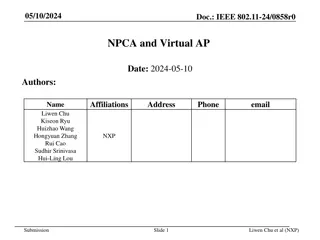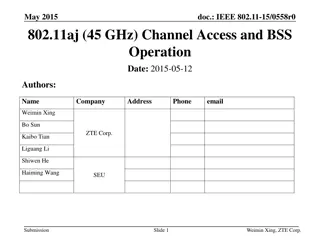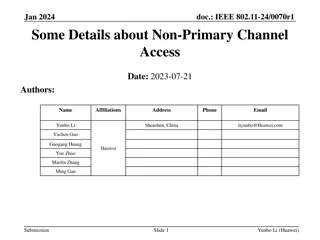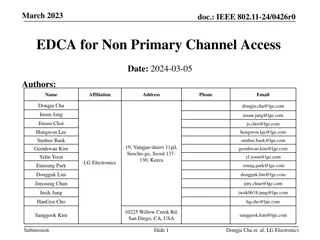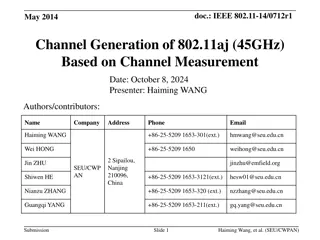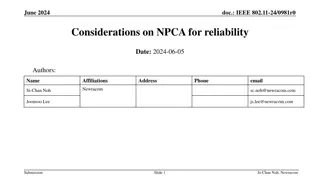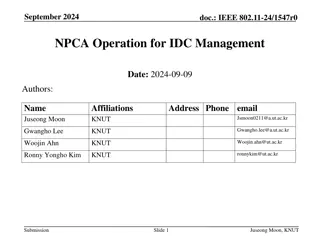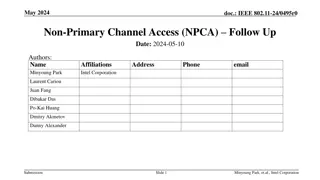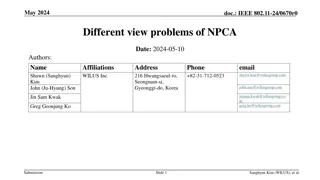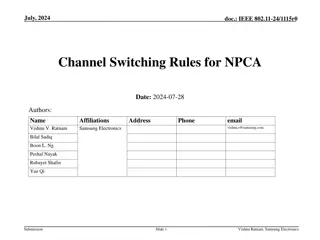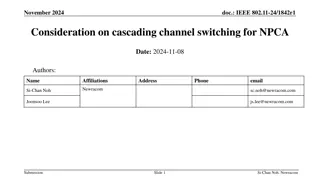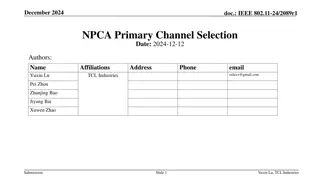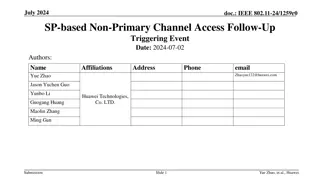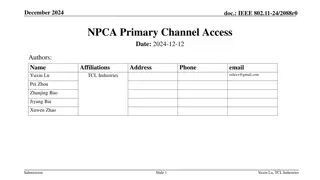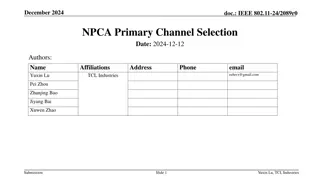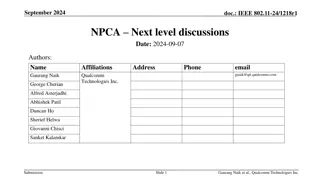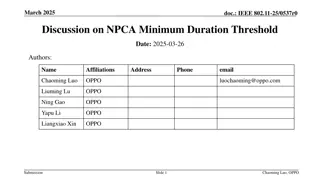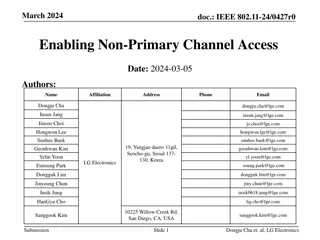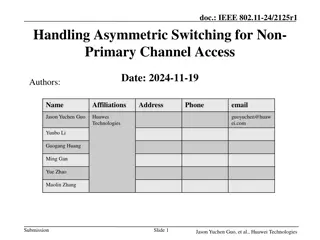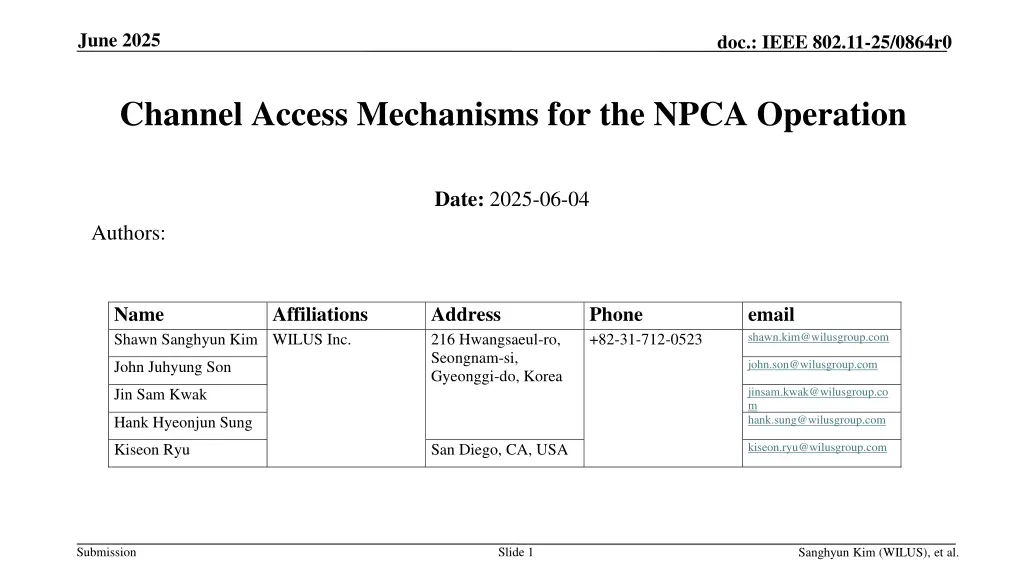
Channel Access Mechanisms for NP-CA Operation Discussion
Explore the channel access mechanisms for NP-CA operation in IEEE 802.11-25/0864r0 document. Discusses modifications ensuring timely TXOP acquisition for NP-CA APs. Details include NP-CA STA behavior, EDCA parameters, TXOP initiation rules, backoff procedures, and deferment mechanisms. Proposal to implement Mechanism 2 for NP-CA STAs to prevent simultaneous transmission issues.
Download Presentation

Please find below an Image/Link to download the presentation.
The content on the website is provided AS IS for your information and personal use only. It may not be sold, licensed, or shared on other websites without obtaining consent from the author. If you encounter any issues during the download, it is possible that the publisher has removed the file from their server.
You are allowed to download the files provided on this website for personal or commercial use, subject to the condition that they are used lawfully. All files are the property of their respective owners.
The content on the website is provided AS IS for your information and personal use only. It may not be sold, licensed, or shared on other websites without obtaining consent from the author.
E N D
Presentation Transcript
June 2025 doc.: IEEE 802.11-25/0864r0 Channel Access Mechanisms for the NPCA Operation Date: 2025-06-04 Authors: Name Shawn Sanghyun Kim WILUS Inc. Affiliations Address 216 Hwangsaeul-ro, Seongnam-si, Gyeonggi-do, Korea Phone +82-31-712-0523 email shawn.kim@wilusgroup.com john.son@wilusgroup.com John Juhyung Son jinsam.kwak@wilusgroup.co m hank.sung@wilusgroup.com Jin Sam Kwak Hank Hyeonjun Sung kiseon.ryu@wilusgroup.com Kiseon Ryu San Diego, CA, USA Submission Slide 1 Sanghyun Kim (WILUS), et al.
June 2025 doc.: IEEE 802.11-25/0864r0 Introduction Some details of the channel access mechanism on the NPCA primary channel are defined in TGbn D0.2 [1] NPCA STAs that perform channel access on the NPCA primary channel reuse the conventional EDCA mechanism with some exceptions This contribution discusses the channel access mechanism that defers transmission considering the NPCA switching delay, and proposes necessary modifications to ensure that an NPCA AP which has completed its backoff procedure first can be guaranteed TXOP acquisition Submission Slide 2 Sanghyun Kim (WILUS), et al.
June 2025 doc.: IEEE 802.11-25/0864r0 Channel access on the NPCA primary channel Channel Access Mechanism on the NPCA primary channel The NPCA STA operating on the NPCA primary channel Use the same (MU, EPCS) EDCA parameter set for the NPCA primary channel as it uses on the BSS primary channel May initiate a TXOP on the NPCA primary channel by following the rules defined in 10.23.2.2 (EDCA backoff procedure) and 10.23.2.4 (Obtaining an EDCA TXOP) with the following exceptions Each time that the NPCA STA switches to the NPCA primary channel, it shall initialize CW_NPCA[AC] to TBD value and randomly choose a new backoff counter between 0 and CW_NPCA[AC] QSRC_NPCA[AC] shall be set to 0 If the STA is a non-AP STA and the associated AP has disabled the use of untriggered UL transmission, then the STA shall not initiate a TXOP on the NPCA primary channel Additional rule for the NPCA STA The NPCA STA shall not initiate a transmission on the NPCA primary channel to another NPCA STA until that STA's NPCA switching delay time has elapsed The specific method by which an NPCA STA defers its transmission initiation on the NPCA primary channel, in consideration of the switching delay of the peer NPCA STA, is not clearly defined Submission Slide 3 Sanghyun Kim (WILUS), et al.
June 2025 doc.: IEEE 802.11-25/0864r0 Mechanism for deferring TX initiation Two different mechanisms for deferring Tx initiation in the baseline [2]: Mechanism 1. Maintaining the backoff counter at 0 For the STAs with empty Tx queue or the STAs transmitting a Start Time Sync PPDUs Mechanism 2. Regenerate a random backoff counter using the current CW[AC] value when the BO is reached to 0 For the case where the start time of an R-TWT SP is imminent 0000 210 ICF 4321 0 210 ICF ICR ICR S80 S W S80 S W AP AP OBSS TXOP OBSS TXOP P80 P80 ICR ICF ICR Non-AP STA1 ICF Non-AP STA1 S80 S80 switching switching OBSS TXOP OBSS TXOP P80 P80 Mechanism 2 Mechanism 1 We propose to reuse the Mechanism 2 for the NPCA STAs Applying the Mechanism 1 to the NPCA may cause multiple NPCA STAs to begin transmitting simultaneously after the NPCA AP s switch delay, potentially resulting in collisions Submission Slide 4 Sanghyun Kim (WILUS), et al.
June 2025 doc.: IEEE 802.11-25/0864r0 Problem statement Background It seems natural for an NPCA AP must defer its transmission until the NPCA STA with the longest switching delay among the intended recipients completes switching Problem During this deferral period, another NPCA STA may initiate NPCA ICF transmission If the AP that completes the backoff procedure first is not guaranteed to obtain the TXOP, the AP may attempt to increase its chances by scheduling only NPCA non-AP STAs with short switching delays This implies that the benefits of NPCA operation could become concentrated only among STAs with shorter switching delays To address the issue, it is necessary to ensure that all the NPCA non-AP STAs also defer their transmissions during the time when the AP is deferring its transmission initiation 543210432 210 BA ICF UL PPDU ICR S80 S W AP OBSS TXOP P80 Deferred due to NPCA switching delay of another STA 210 BA ICR UL PPDU ICF S80 Non-AP STA1 switching OBSS TXOP P80 Submission Slide 5 Sanghyun Kim (WILUS), et al.
June 2025 doc.: IEEE 802.11-25/0864r0 Proposal UL TXOP Restriction Duration To prevent NPCA non-AP STAs from initiating uplink transmissions while an NPCA AP is deferring its own transmission, a mechanism to restrict the initiation of UL TXOPs may be considered The AP can indicate a UL TXOP Restriction Duration through the NPCA Operation Information field element When the AP sets a non-zero UL TXOP Restriction Duration, non-AP STAs shall not initiate a UL TXOP on the NPCA primary channel until the indicated duration has expired The AP may set UL TXOP Restriction Duration covering the longest NPCA switching delay among the NPCA STAs in the BSS to obtain sufficient scheduling flexibility NPCA Primary Channel NPCA Minimum Duration Threshold NPCA Switching Delay NPCA Switch Back delay UL TXOP Restriction Duration NPCA Operation Information field format Submission Slide 6 Sanghyun Kim (WILUS), et al.
June 2025 doc.: IEEE 802.11-25/0864r0 Proposal (cont d) UL TXOP Restriction Duration (cont d) Since EDCAF operates based on aSlotTime, it is reasonable to consider using a unit of 9 s (or its multiple) for the UL TXOP Restricted Period When the UL TXOP Restricted Period is set to its maximum value, it may indicate that untriggered UL transmissions on the NPCA primary channel are prohibited In this case, the signaling of untriggered UL transmission disablement already introduced in D0.2 can be achieved through the UL TXOP Restricted Period field NPCA non-AP STA operation When the UL TXOP Restricted Period is indicated by the AP, non-AP STAs shall defer the start of their transmissions during the indicated period A non-AP STA that defers its transmission due to the UL TXOP Restricted Period may use the same mechanism as when deferring based on the NPCA switching delay, i.e., by re-generating the backoff counter Submission Slide 7
June 2025 doc.: IEEE 802.11-25/0864r0 Benefits of the Hybrid NPCA Operation Mode When a non-zero/non-maximum UL TXOP Restriction Duration is designated by the NPCA AP, NPCA operation is carried out in a hybrid form that combines Trigger-only mode and EDCA mode This hybrid NPCA operation mode not only ensures that the AP which completes its backoff procedure first gains the TXOP, but also offers the following additional benefits Effective Utilization of NPCA Opportunities: The Trigger-only mode is effective in mitigating the "different view" problem among NPCA STAs However, in Trigger-only operation, if the NPCA AP does not transmit a Trigger Frame or DL PPDU, the NPCA opportunity may be lost In contrast, under the hybrid mode, the NPCA opportunity can be utilized by the NPCA non-AP STAs when the UL TXOP Restriction Duration expires Improved Fairness Among NPCA STAs: An NPCA STA with a longer switching delay enable to begin contention on the NPCA primary channel later than one with a shorter delay, potentially causing fairness issues in EDCA-based NPCA operation In hybrid mode, since UL TXOP initiation is restricted before the expiration of the UL TXOP Restriction Duration, the fairness issue among NPCA STAs can be alleviated Submission Slide 8 Sanghyun Kim (WILUS), et al.
June 2025 doc.: IEEE 802.11-25/0864r0 Summary The channel access mechanism on the NPCA primary channel for deferring the start of transmission has been discussed Reusing the baseline mechanism generating a new random backoff counter when the backoff counter reaches zero is preferred The issue where an NPCA AP that has completed the backoff procedure may lose the opportunity to initiate its TXOP has been discussed A UL TXOP Restriction Duration was proposed to ensure AP s TXOP initiation The benefits of the hybrid NPCA operation mode have been discussed Submission Slide 9 Sanghyun Kim (WILUS), et al.
June 2025 doc.: IEEE 802.11-25/0864r0 References [1] Draft P802.11bn D0.2 [2] Draft P802.11be D7.0 Submission Slide 10 Sanghyun Kim (WILUS), et al.


